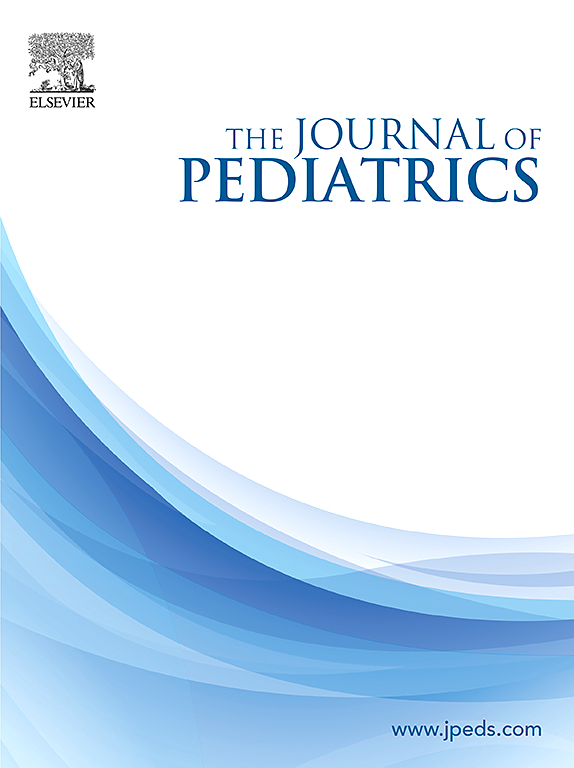Effects of Remote Patient Monitoring on Neonatal Intensive Care Unit Patients Discharged with Nasogastric Tube Feeding
IF 3.5
2区 医学
Q1 PEDIATRICS
引用次数: 0
Abstract
Objective
To examine whether discharge with remote patient monitoring (RPM) is associated with improved outcomes among infants discharged from the neonatal intensive care unit with a nasogastric tube (NGT).
Study design
This was a retrospective cohort study of infants discharged with an NGT from the Cincinnati Children's Hospital Medical Center neonatal intensive care unit from 2015 to 2022. Infants were divided into pre-RPM and RPM cohorts. Differences in clinical characteristics, weight at follow-up, and unplanned health care utilization were evaluated using multivariable generalized linear regression models.
Results
There were 385 eligible patients (n = 139 pre-RPM, n = 246 RPM). Infants discharged with RPM had higher rates of prematurity. The RPM group was discharged at an earlier postmenstrual age (43.00 vs 44.12 weeks, P = .0102) and had more favorable change in weight z-score at follow-up (0.21 [0.03, 0.4] at 3 months, 0.34 [0.09, 0.58)] at 6 months). The risk of unplanned admissions or emergency department visits was 53% lower in the RPM group than in the pre-RPM group (risk ratio = 0.47 [0.28, 0.79]).
Conclusions
Patients discharged with an NGT plus RPM were discharged at earlier postmenstrual age, had more favorable growth trajectory, and had fewer unplanned health care encounters, indicating that discharge with NGT feeds with RPM appears to be safer and more effective than discharge with NGT feeds without RPM.
远程监护对新生儿重症监护病房鼻胃管喂养出院患者的影响。
目的:探讨在新生儿重症监护病房(NICU)使用鼻胃管(NGT)出院的婴儿中,采用远程患者监护(RPM)出院是否与改善预后相关。研究设计:这是一项回顾性队列研究,研究对象为2015-2022年辛辛那提儿童医院医学中心NICU出院的NGT婴儿。婴儿被分为RPM前组和RPM组。使用多变量广义线性回归模型评估临床特征、随访体重和计划外医疗保健利用的差异。结果:385例符合条件的患者(N=139 RPM前,N=246 RPM)。以RPM出院的婴儿有较高的早产率。RPM组出院时PMA较早(43.00 vs. 44.12周,p=0.0102),随访时体重z评分变化更有利(3个月时为0.21[0.03,0.4],6个月时为0.34[0.09,0.58])。RPM组意外入院或急诊就诊的风险比RPM前组低53% (RR = 0.47[0.28, 0.79])。结论:NGT加RPM的患者出院时PMA更早,生长轨迹更有利,计划外医疗遭遇更少,表明NGT加RPM的出院比NGT不加RPM的出院更安全、更有效。
本文章由计算机程序翻译,如有差异,请以英文原文为准。
求助全文
约1分钟内获得全文
求助全文
来源期刊

Journal of Pediatrics
医学-小儿科
CiteScore
6.00
自引率
2.00%
发文量
696
审稿时长
31 days
期刊介绍:
The Journal of Pediatrics is an international peer-reviewed journal that advances pediatric research and serves as a practical guide for pediatricians who manage health and diagnose and treat disorders in infants, children, and adolescents. The Journal publishes original work based on standards of excellence and expert review. The Journal seeks to publish high quality original articles that are immediately applicable to practice (basic science, translational research, evidence-based medicine), brief clinical and laboratory case reports, medical progress, expert commentary, grand rounds, insightful editorials, “classic” physical examinations, and novel insights into clinical and academic pediatric medicine related to every aspect of child health. Published monthly since 1932, The Journal of Pediatrics continues to promote the latest developments in pediatric medicine, child health, policy, and advocacy.
Topics covered in The Journal of Pediatrics include, but are not limited to:
General Pediatrics
Pediatric Subspecialties
Adolescent Medicine
Allergy and Immunology
Cardiology
Critical Care Medicine
Developmental-Behavioral Medicine
Endocrinology
Gastroenterology
Hematology-Oncology
Infectious Diseases
Neonatal-Perinatal Medicine
Nephrology
Neurology
Emergency Medicine
Pulmonology
Rheumatology
Genetics
Ethics
Health Service Research
Pediatric Hospitalist Medicine.
 求助内容:
求助内容: 应助结果提醒方式:
应助结果提醒方式:


